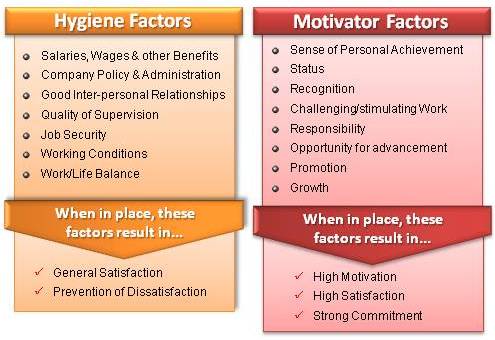HRM

A major work in the field of employee motivation is done by Frederick Hertzberg (1964) that includes Two-factor Theory among other works of the author. According to the Two-Factor Theory a distinction has to be made in the workplaces between motivators and hygeine factors. Motivators cause the employees to enhance the level of their performance and effectiveness in the workplace and include career growth, responsibility, achievement etc. Hygeine factors, on the other hand, are essential in the workplaces in order for the employees not to be dissatisfied, at the same time, when these factors do not cause satisfaction. Hygiene factors include job security, financial compensation, the quality of management etc., whereas motivator factors are recognition of contribution by management, personal and professional growth opportunities, status associated with the position etc. It is important for managers to be able to make clear distinction between motivators and hygiene factors. This is because while the provision of hygiene factors may lead to greater level of employee satisfaction, it does not necessarily contribute to the level of employee motivation. Therefore, apart from ensuring the provision of hygiene factors in an effective manner, managers need to invest in motivational factors as well.

Most people believe that every human being is equal and he/she is entitled to the same rights, privileges and opportunities, regardless their race, gender, faith or age. This fundamental belief changed the way management practices such as the recruitment, training and development of employees are done. In order to fully understand the benefits and disadvantages of multicultural workplace, first of all, the concept of diversity must be fully defined and understood. There are number of definitions for diversity: Diversity is a mix of people of different socially relevant group identities working or living together Diversity means any differences between people Diversity means differences of gender, age, race and ethnic group Diversity is state of being different Therefore, in a nutshell, diversity can be defined as that recognizing, appreciating, valuing and utilising the unique talents and contributions of all individuals regardless of age, career experience, colour, culture, disability, religion, speed of learning etc. Managing diverse workforce can help the company to expand its business and reach to minor communities as they can be able to understand needs of customers from different background. That is to say that diversity is opportunity focused and if managed effectively, it can: Increase productivity Reduce turnover Increase creativity and innovation Increase employee satisfaction Open new markets Further, diversity does not involve any legal requirements or is not implemented just to avoid lawsuits. On contrary, whether to implement diversity is at the discretion of the management. However, managing diverse workforce can be challenge too. If not managed properly, it can cause: Lower productivity Cultural misunderstanding Miscommunication Create conflicts Lack of teamwork

Bloisi (2007, p43) states that when an organisation has decided on a course of strategic action, it is the role of the HR department to find and develop its people to enable the strategies to be achieved. As such, Elite tennis club has also made a strategic decision to acquire new wasteland to develop and add as part of its own business activities. Therefore, it is the role of HR department to overlook and provide sufficient expertise to realize the business objectives of the company. Gupta (2005, p176) mentions that before the company actively starts recruiting, there should be a Human Resource Planning which involves forecasting and determining the number of manpower required by the organization in future keeping in view its present activities and future plans. To recruit new employees, Elite HR department needs to take into account factors in the external environment such as availability of labour, skills, education and employment costs. Moreover, it also needs to look at the internal environment inside the organisation. And the following questions need to be asked: Where does it need the labour? What skills do staff need? What training and development is important for the organization? Furthermore, Gupta (2005, p172) indicates that staffing is a management process where an organization needs to identify the needs for recruitment, the level of labour, expertise and the number and budget for employment. And if the recruitment is going to be internal or external is also identified just before the recruitment process starts. The aim of the personnel department is to attract the best candidates for the job and then to choose the most suitable. If the wrong person is recruited, then this can cause problems for a business. Adopted from: Gupta 2005, Business studies Gupta (2005) says that once the number and type of…
By John Dudovskiy
Category: HRM

The core of HRM is to attract, develop and maintain an effective workforce within an organisation. Attracting an effective workforce includes HR planning, job analysis, forecasting, recruiting and selection. Developing that workforce includes the training, appraisal and career development. Maintaining the workforce includes such matters as financial rewards, non financial benefits, labour relations and termination formalities. It is proposed to transfer at least one important HR function to the proposed subsidiary. Since the most important and one of the difficult HR functions is the staffing of an overseas subsidiary, it is intended to transfer this function to the new organisation. This includes selecting, placing and locating employees in the new organisation. It is necessary to select a blend of workforce including managers, who possess the appropriate levels of technical, human and conceptual skills as required in their respective roles so it is ideal to transfer this responsibility to the new organisation who knows best the local conditions. When staffing multinational assignments cost is a major implication that needs to be seriously considered especially when need arises to establish a professional manager in another country. Multinational organisations can be staffed in a number of ways. In addition, staffing of a overseas subsidiary is done with citizens of different countries, different tax laws, regulations, customs and other factors. International employees can be categorised into three types, namely expatriates, host-country nationals and third-country nationals. The latter category is where the parent company is in say, country A, the subsidiary company in country B but the employee concerned is from some other country say country C. In deciding as to how to staff the multinational organisation, the local HR manager should consider the nature, purpose as well as the length of the assignment. According to Mathis & Jackson (2005), multinational assignments requiring multicultural capabilities…
By John Dudovskiy
Category: HRM

Where a decision has been taken to establish a subsidiary in the overseas it is necessary to manage human resources in that economy in a different cultural background and legal systems. This in itself is a challenge for me as the HR manager of the Parent Company. My discussion here will concentrate on following factors Legal and Political Socio cultural Economic Local HR and Employment conditions Legal and Political Before setting up a wholly-owned subsidiary, a review and careful analysis of legal implications and political stability of the host country is important as they vary from country to country. Sri Lanka was involved with a fierce civil war for well over 30 years and in the month of May 2009, we saw an end to this civil war. Followed by the end of civil war, in 2010 January, a Presidential election was held and people opted the same President to continue for another term of six years. The Parliamentary election which followed also was won by the ruling party of the President and this was a clear sign of the country achieving political stability. Many developed countries and International Donor agencies such as World Bank, ADB and JICA has promised substantial financial assistance for the rehabilitation of Northern and Eastern Provinces which were severely affected by the war. The new Government also has invited the international investors for productive investment in Sri Lanka and has promised every incentive for the new investors. The decision by our company is also a result of this initiative by the Sri Lankan Government Sri Lanka also possess an independent foreign policy and also it is a member of commonwealth nations since gaining independence and a member of UN. A favourable non-aligned foreign policy in a host country is very vital for…
By John Dudovskiy
Category: HRM

One of the most comprehensive definitions of human resources management defines the term as “the policies and practices involved in carrying out the ‘people’ or human resource aspects of a management position, including recruitment, screening, training, rewarding and appraising” (Randhawa, 2007, p.2). Essential characteristics of human resources have been specified as valuable, rare, inimitable, and non-substitutable (Deb, 2006). Strategic human resource management, on the other hand, can be explained as an approach defining the manner in which organisational aims and objectives is going to be achieved through people with the use of HR strategies, as well as, integrated HR policies and practices (Armstrong, 2009). In other words, the main difference between HRM and strategic HRM relates to strategic framework the latter form of HRM adopts in relation to supporting long-term organisational aims and objectives. Three basic propositions of strategic HRM consist of idea that “the human resources or human capital of an organisation play a strategic role in its success and are a major source of competitive advantage” (Armstrong, 2008, p.34), integration needs to be maintained between HR strategies and business plans, and individual HR strategies need to be linked to each other in order to achieve horizontal integration. Increasing numbers of organisations are giving preference to strategic HRM approach over traditional HRM because a strategic approach effectively contributes to the improvement of a wide range of organisational elements and processes such as employee loyalty, organisational culture, organisational structure, effectively matching available resources in order to meet the demands of the future. Learning organisation can be defined as “an organisation in which everyone is engaged in identifying and solving problems, enabling the organisation to continuously experiment, improve, and increase its capacity” (Thomson and Baden-Fuller, 2010, p. 295). The role of HRM systems in facilitating organisational learning can be explained in…
By John Dudovskiy
Category: HRM

The so-called new science has been perceived as a possible source of influence on HRM by Audrey Collin (2010) in Contextualising HRM: developing critical thinking. The new science approach, also known as a holistic approach involves studying issues as a whole, rather than by dividing them into components. This approach has been developed to challenge Newton’s mechanic notion of universe that advocates the idea of dividing ideas and objects into small forming components so that they can be studied with an increased level of efficiency (Achouri, 2012). Collin (2010) advocates the idea of adopting a holistic approach towards HRM by convincingly claiming that this approach will assist in understanding the complexity of issues. Specifically, the author states that “to understand complexity, new approaches that recognise the whole rather than just its parts – a holistic approach – and attention to relationships between the parts needed, and these are being developed” (Collins, 2010, p.98). This viewpoint towards business management in general and HRM in particular deserves to be agreed with for several reasons. First of all, HRM functions need to be reminded and analysed to justify this claim. The functions of HRM can be divided into two, managerial and operative categories. Managerial HRM functions include planning, organising, staffing, directing, and controlling, whereas, operative functions consist of procurement, development, compensation, maintenance and motivation, integration, and industrial relations (Pravin, 2010). According to new science, or holistic approach these HRM functions need to be dealt with as whole, rather than separate components. For instance, “HR planning aims, in general, for the target and task oriented allocation of employable human resources for a specified or indefinite period” (Michalski, 2011, p.13). If this important HR function is dealt with as a separate issue from other HR and other organisational functions, than this may lead to loss of…
By John Dudovskiy
Category: HRM

There are no universal learning and training principles that relate to all work situations and environmental settings in the same manner. In other words, there is a wide range of economical, cultural, political, legal, environmental and other factors that affect the formation and utilisation of learning and training principles within individual work situations and environmental settings. This paper is mainly concerned with the provision of learning and training in Chinese organisations in particular, taking into account a wide range of specific characteristics and circumstances associated with China and various forms of organisations operating in that country. The following table represents the key characteristics of HR training and development in various forms of ownership in China and a range of factors that have contributed to the formation of these characteristics are discussed further below. Government and civil service organisations State-owned enterprises Private enterprises Joint ventures and large multinational companies Training and development is provided at relatively high levels with increased focus on political studies Training and development is provided mainly to managerial, professional and technical staff The lowest level of formal training and development opportunities for employees compared to other forms of ownership High level of training and development opportunities provided to employees Table 1: Key characteristics of HR training and development in various forms of ownership in China Source: Storey (2011) The Economy of China and its Impact on Learning and Training Today China is seen by many as an emerging economic superpower with GDP growth of 10.45 per cent in 2010 and forecasts for growth of 10-12 per cent yearly for the next several years to reach 9,982.08 billion USD in 2015 (Economywatch, 2012, online). The main drivers behind dramatic economic developments in China are perceived to be important economic reforms that have enabled the utilisation of advantages…

Increasing forces of globalisation have turned mergers and acquisitions in an international level into a common business practice engaged in by multinational companies (Joshi, 2009). However, mergers and acquisitions between companies from different countries are associated with a set of challenges that relate to differences in legislation, organisational structures, corporate cultures etc. Unless these issues are addressed timely and effectively, the proposed joint-venture between the companies may fail which would result in negative consequences in many levels. This article represents an audit of the business environment of South Korean market the company operating in garment industry is planning to enter. The audit is undertaken from HR perspective and explores some of the related issues. Specifically, the article includes an analysis of key economic drivers is South Korea, a comparative analysis of HR systems in UK, Europe and US and a brief analysis of organisational, national and cultural issues that affect the development and implementation of HRM strategy. An Analysis of Key Economic Drivers in South Korea Ten global economic drivers are identified as food, shelter, clothing, government, transportation, communication, information processing, energy, industrial materials and entertainment (Drivers, 2011, online). While offering grounds for competitive edge for business operating within the country, economic drivers also attract foreign businesses that aim to use economic drivers of the country in order to obtain competitive advantage in the marketplace. At the same time, economic drivers have their implications for the development and implementation of HRM strategies as well. Lately, the broadband speed is seen as an alternative key economic driver and “South Korea is the winner, with an average speed of 22.47Mbps, but it is closely followed by Japan and countries in Eastern Europe and Scandinavia” (Dawson, 2010, online). Moreover, fuel cells have also been declared by South Korea as its key economic…
By John Dudovskiy
Category: HRM

It has been stated that “reward management deals with the strategies, policies and processes required to ensure that the contribution of people to the organisation is recognised by both financial and non-financial means” (Armstrong, 2007, p.3). To put it simply rewards are used in order to thank employees, for their increased performances and more importantly, to motivate and inspire them to achieve greater results in the future, therefore, effective reward management systems are crucial to the successful implementation of SHRM. The aims of reward management are listed by Wood (2009) as rewarding employees according to the value created by them, relating the reward practices to the individual employee needs and values, communicating specific messages to the stakeholders in general and to employees in particular through rewards, attracting highly qualified and competent workforce, and motivating employees for high-level performances. Important components of an effective reward management system are specified by Armstrong (2007) as reward philosophy, distributive justice, procedural justice, fairness, equity, consistency, transparency, strategic alignment, conceptual and culture fit, as well as fitting for purpose. Each of these issues needs to be addressed by management in an effective manner in order to maximise the output of reward initiatives. Rewards are usually divided into two groups: tangible and intangible. The most popular forms of tangible rewards include monetary rewards, in the forms of pay-raises and bonuses and other tangible items such as holidays, gifts, free samples of products etc. Intangible rewards, on the other hand, include verbal and written appraisals, appreciation letters, articles in the company and local press etc. The choice between tangible and intangible rewards depends on a range of factors that include cultural background of employees, their personal values, characteristics and traits etc. However, Wood (2009) informs that according to the latest studies intangible rewards in general and the…
By John Dudovskiy
Category: HRM
